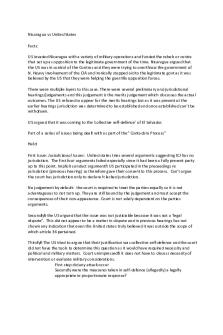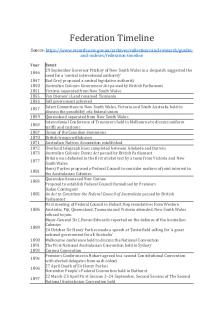Nicaragua Timeline Notes PDF

| Title | Nicaragua Timeline Notes |
|---|---|
| Author | Lanse Mitchell |
| Course | American Foreign Policy |
| Institution | University of Rhode Island |
| Pages | 4 |
| File Size | 79.3 KB |
| File Type | |
| Total Downloads | 46 |
| Total Views | 145 |
Summary
In depth notes from lecture. Discusses US interference in Nicaragua during the 1900's. The teacher was James Buxton and he was a really good teacher that required a large amount of papers and notes for surprise quizzes and what not....
Description
NICARAGUA TIMELINE NOTES (not a lot of Nicaraguans illegally crossing the US border despite it being the poorest country in Central America) EARLY 1850s: Cornelius Vanderbilt constructs a ferry system across Lake Nicaragua 1855: William Walker and 58 other Americans (from Tennessee) are recruited by one Civil War in Nicaragua
side of
1856: Walker has himself “elected” as President of Nicaragua ● Makes English the official language; legalizes slavery; indicates his interest in taking over the rest of Central America 1857: Walker is defeated by a combined Central American force 1912-1925; 1926-1933: US Marines occupy Nicaragua 1927 – 1933: Augusto Sandino leads a rebel force which attempts to drive the Marines Nicaragua
out of
1933: US Marines leave Nicaragua ● Set up Anastasio Somoza as Head of the National Guard ● 1936: Somoza forces existing President out, and claims the Presidency 1936 – 1979: Somoza, and then his two sons rule Nicaragua as dictators US relations: FDR referred to the eldest Somoza as an S.O.B., “but at least he’s our S.O.B.” 1961 - 1979: Sandinista Front for National Liberation (FSLN) forms, and then fights a guerilla war vs the Somoza dictatorship With the mounting social crisis, political-military conflict and increasing repression by the Somoza dictatorship in Nicaragua, a large number of Nicaraguans migrated to other countries. It is calculated that some 280,000 people left Nicaragua during the Somoza years, at least 80,000 headed for Costa Rica. This migration was obviously more political than work-related. (Univ of Costa Rica; 2006) 1979: Sandinista Revolution succeeds ● FSLN government (Sandinistas) led by President, Daniel Ortega, nationalizes lands held by the Somoza family, and turns the seized land into cooperatives
● Ortega invests heavily in health and education; allies with Cuba 1980 – 1982: US publically sponsors attacks by Contra rebels based in Honduras Contras: Who were they? a) Somocistas b) business community; large landowners c) Those who felt that Sandinistas had captured the revolution d) Those who opposed mandatory draft e) Those who profited from drug trade f) Those who opposed Sandinista support for left wing guerillas in El Salv. g) Those who opposed some of the Sandinistas alliances 1982: US Senate passes the Boland Amendment which forbids any US funds to be used in support of the Contras. The US CIA secretly aids the Contras until the late 1980s 1984 - Daniel Ortega elected president in controversial election; US CIA mines harbors and is condemned by the World Court for doing so.
Nicaraguan
1985: Nicaragua shoots down a Contra cargo plane, which serves as proof of US support for the Contras. A sister plane was then abandoned in Costa Rica. 1987-88 - Nicaraguan leadership signs peace agreement and subsequently holds talks with Contras. This peace treaty was arranged with the help of Costa Rican President, Oscar Arias Sanchez. 1990 - US-backed center-right National Opposition Union defeats FSLN in elections 2006 – 2011: 2011 – the present: Daniel Ortega has been the President 2011: Ortega won the Presidential election by a wide margin 2016) “Daniel Ortega cruised to victory in the 2016 presidential election to win a third consecutive five-year term. Independent election observers, as well as opposition figures and the US voiced deep concern about the fairness of the poll. Mr Ortega's opponents have accused the former fighter of seeking to consolidate his family's control over Nicaraguan politics by appointing relatives to key posts and side-lining opposition candidates. M.r Ortega has strong support from the country's poor who account for more than a third of the population and have benefitted from his social programs. During his tenure, Nicaragua has experienced stable economic growth, poverty levels have fallen and low violence compared to elsewhere in Central America.” (BBC)
2018 November: Nicaragua in Crisis: What to Know: Council on Foreign Relations:
Not long ago Nicaragua seemed to be an island of calm in an otherwise turbulent corner of the world. The country was one of the poorest in the hemisphere and long ruled by a leftist autocrat and his wife, but its economy was plugging along and its streets were peaceable, particularly in comparison to its Northern Triangle neighbors—El Salvador, Guatemala, and Honduras. What happened? How did conditions spiral so quickly?
Until April 2018, Nicaragua was a tourism hot spot and home to one of Latin America’s fastest-growing economies, ticking upward at about 5 percent per year. President Daniel Ortega, who for years had consolidated power through nepotism and graft, maintained popular support by administering welfare programs for the nation’s poor. Things began to turn, however, after longtime benefactor Venezuela pulled its aid in 2017 amid an economic collapse of its own. As Caracas turned off the spigot, which was running at hundreds of millions of dollars a year, Nicaragua was forced to cut back. The spark that lit the fuse came April 2018, when President Ortega announced he would slash social security benefits as a cost-cutting measure. Backed by business leaders, an outraged public took to the streets by the hundreds of thousands to demand Ortega’s resignation, which prompted a crackdown by government and paramilitary forces that has left hundreds dead and many more injured. The violence, which peaked over the summer, has drawn widespread condemnation from human rights groups, regional organizations, and foreign governments, including the United States. The United Nations has accused the Ortega administration, the military, and the police of human rights violations, including torture and extrajudicial killings. The Trump administration has sanctioned several senior Nicaraguan officials, and in November it characterized Nicaragua along with Cuba and Venezuela as a “troika of tyranny.” The Catholic Church, meanwhile, has tried and failed to broker talks between Ortega and the opposition. (Council of the Americas; April 18, 2019) “Since civil unrest first broke out against the administration of Daniel Ortega on April 18, 2018, more than 300 people have been killed, 900 people remain political prisoners, and an estimated 60,000 Nicaraguans emigrated—mostly heading south to Costa Rica. Meanwhile, the country of 6 million lost 450,000 jobs last year and has seen its economy go from around 5 percent GDP growth to a nearly 4-point contraction in the span of 12 months. A tax overhaul passed in February aimed to raise funds for the cash-strapped Ortega administration, but so far is only exacerbating the problem. Who stepped in to Ortega’s aid with a $100 million loan? Taiwan, which continues its tug-of-war with China over recognition in Central America.”...
Similar Free PDFs

Nicaragua Timeline Notes
- 4 Pages

Nicaragua Oxfam - Lecture notes
- 2 Pages

01 - DNA Timeline - Notes
- 2 Pages

Símbolos patrios de Nicaragua
- 9 Pages

Nicaragua Mini Proyecto
- 1 Pages

Brexit Timeline
- 1 Pages

China Timeline
- 2 Pages

Nicaragua vs United States
- 6 Pages

Colonial Timeline
- 5 Pages

Federation Timeline
- 3 Pages

History Timeline
- 4 Pages

Codigo de comercio de nicaragua
- 193 Pages
Popular Institutions
- Tinajero National High School - Annex
- Politeknik Caltex Riau
- Yokohama City University
- SGT University
- University of Al-Qadisiyah
- Divine Word College of Vigan
- Techniek College Rotterdam
- Universidade de Santiago
- Universiti Teknologi MARA Cawangan Johor Kampus Pasir Gudang
- Poltekkes Kemenkes Yogyakarta
- Baguio City National High School
- Colegio san marcos
- preparatoria uno
- Centro de Bachillerato Tecnológico Industrial y de Servicios No. 107
- Dalian Maritime University
- Quang Trung Secondary School
- Colegio Tecnológico en Informática
- Corporación Regional de Educación Superior
- Grupo CEDVA
- Dar Al Uloom University
- Centro de Estudios Preuniversitarios de la Universidad Nacional de Ingeniería
- 上智大学
- Aakash International School, Nuna Majara
- San Felipe Neri Catholic School
- Kang Chiao International School - New Taipei City
- Misamis Occidental National High School
- Institución Educativa Escuela Normal Juan Ladrilleros
- Kolehiyo ng Pantukan
- Batanes State College
- Instituto Continental
- Sekolah Menengah Kejuruan Kesehatan Kaltara (Tarakan)
- Colegio de La Inmaculada Concepcion - Cebu



